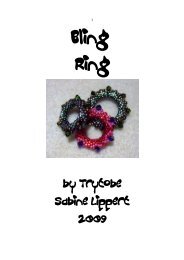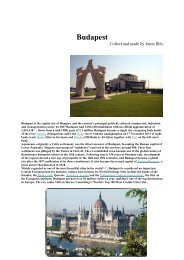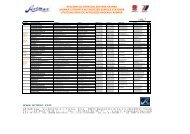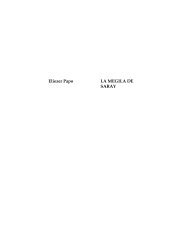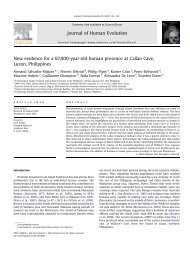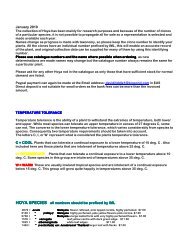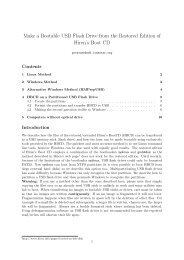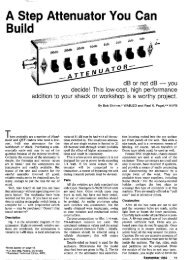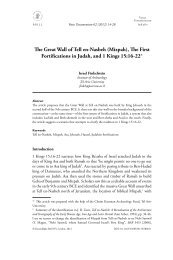ARTICLE IN PRESS Journal of Human Evolution
ARTICLE IN PRESS Journal of Human Evolution
ARTICLE IN PRESS Journal of Human Evolution
Create successful ePaper yourself
Turn your PDF publications into a flip-book with our unique Google optimized e-Paper software.
6<br />
Table 3<br />
DFA classification results.<br />
<strong>ARTICLE</strong> <strong>IN</strong> <strong>PRESS</strong><br />
A. Actual rows by predicted columns for subfamilial DFA classification results: counts and (%), DFA correctly classified 89.5% <strong>of</strong> original grouped cases.<br />
Cercopithecinae Colobinae Total<br />
Cercopithecinae 120 (89.6) 14 (10.4) 134<br />
Colobinae 2 (11.1) 16 (88.9) 18<br />
B. Actual rows by predicted columns for leave-one-out cross validation for subfamilial DFA classification results: counts and (%), DFA correctly classified<br />
ca. 89% <strong>of</strong> cross-validated grouped cases.<br />
Cercopithecinae Colobinae Total<br />
Cercopithecinae 119 (88.8) 15 (11.2) 134<br />
Colobinae 2 (11.1) 16 (88.9) 18<br />
C. Actual rows by predicted columns for cercopithecine genera DFA classification results: counts and (%), DFA correctly classified 84.1% <strong>of</strong> original grouped cases.<br />
Cercopithecus Macaca Mandrillus Papio Theropithecus Total<br />
Cercopithecus 21 (87.5) 3 (12.5) 0 0 0 24<br />
Macaca 6 (12) 63 (84) 2 (2.7) 0 1 (1.3) 75<br />
Mandrillus 0 1 (10) 7 (70) 2 (20) 0 10<br />
Papio 0 0 0 16 (88.9) 2 (11.1) 18<br />
Theropithecus 0 1 (20) 0 0 4 (80) 5<br />
D. Actual rows by predicted columns for leave-one-out cross validation for cercopithecine genera DFA classification results: counts and (%), DFA correctly<br />
classified ca. 75% <strong>of</strong> original grouped cases.<br />
Cercopithecus Macaca Mandrillus Papio Theropithecus Total<br />
Cercopithecus 19 (79.2) 5 (20.8) 0 0 0 24<br />
Macaca 11 (14.7) 59 (78.7) 2 (2.7) 0 3 (4.0) 75<br />
Mandrillus 1 (20) 1 (10) 5(50) 2 (20) 0 10<br />
Papio 0 0 1 (5.6) 14 (77.8) 3 (16.8) 18<br />
Theropithecus 0 1 (20) 0 1 (20) 3 (60) 5<br />
efficiency may be an additional contributing factor in long limb<br />
skeletal differences between the arboreal M. fascicularis and the<br />
terrestrial M. nemestrina (Rodman, 1979). While he did not consider<br />
the osteological morphology <strong>of</strong> the foot in his original study, it is<br />
intriguing to speculate if this hypothesis can be applied to the<br />
similarities observed here between Theropithecus and Macaca.<br />
Theropithecus forage over much shorter distances while feeding<br />
than the sympatric anubis baboons (Iwamoto, 1993), and perhaps<br />
provide an analogy to the M. fascicularis–M. nemestrina study by<br />
Rodman (1979). If this is correct, the misclassification between<br />
Theropithecus and Macaca fascicularis may be due to similarities in<br />
foraging efficiencies, which may confound the distinction in<br />
calcaneal morphology observed among arboreal and terrestrial<br />
cercopithecines.<br />
Posterior probabilities <strong>of</strong> classification to each taxon were<br />
obtained for each quartile. The results indicate that UB 330 should<br />
be assigned to the genus Theropithecus with a median probability <strong>of</strong><br />
98.5% (with an inter-quartile range <strong>of</strong> 98.1–99.2%). Results indicated<br />
that UB 330 can be assigned to Cercopithecus with a median<br />
probability <strong>of</strong> 1.1% (with an inter-quartile range <strong>of</strong> 0.06–1.67%), and<br />
could be assigned to Papio with a median probability <strong>of</strong> 0.22% (with<br />
an inter-quartile range <strong>of</strong> 0.01–0.35%). Probability <strong>of</strong> assignment to<br />
Macaca and Mandrillus was less than 0.001 percent. The high<br />
posterior probability in assignment <strong>of</strong> UB 330 to Theropithecus with<br />
very narrow inter-quartile ranges provides strong support for the<br />
identification <strong>of</strong> UB 330 as Theropithecus.<br />
In order to understand the morphological differences that may<br />
be driving the distinction between the genera, a scatter plot <strong>of</strong> the<br />
two first functions can be observed (Fig. 4) and analyzed in relation<br />
to the results <strong>of</strong> the stepwise linear DFA (Table 2B).<br />
The DFA plots indicate that the major separation along the first<br />
function, which explains 68.4% <strong>of</strong> the variance, is between the<br />
larger and terrestrial cercopithecine genera (Papio, Mandrillus, and<br />
Theropithecus), which score positive values on the first function,<br />
and the smaller and more arboreal genera (Macaca and<br />
M. Belmaker / <strong>Journal</strong> <strong>of</strong> <strong>Human</strong> <strong>Evolution</strong> xxx (2009) 1–11<br />
Cercopithecus), which score negative values on the first function.<br />
While UB 330 scores clearly in the large terrestrial cercopithecine<br />
group, it occupies a unique position on the plot, specifically in<br />
relation to Theropithecus, and will be discussed later.<br />
The first function is affected primarily by Cal 20 (pedal power<br />
arm). Arboreal taxa such as Macaca have a shorter pedal power arm<br />
compared to more terrestrial taxa, since the ‘‘high gear’’ ratio<br />
contributes to increasing take <strong>of</strong>f velocity required for leaping<br />
locomotion in comparison to a ‘‘lower gear’’ ratio, which is found in<br />
Figure 4. Bivariate plot <strong>of</strong> the first two axes <strong>of</strong> the Discriminant Function Analysis<br />
(DFA) separating the five cercopithecine genera and UB 330. The unique position <strong>of</strong> UB<br />
330 is discussed in the text. Discriminant function 1 explains 68.4% <strong>of</strong> the total<br />
variance, and discriminant function 2 explains 21.1% <strong>of</strong> the total variance. Theropithecus<br />
gelada and T. oswaldi were grouped together in the analysis.<br />
Please cite this article in press as: Belmaker, M., The presence <strong>of</strong> a large cercopithecine (cf. Theropithecus sp.) in..., J Hum Evol (2009), doi:10.1016/<br />
j.jhevol.2009.08.004



